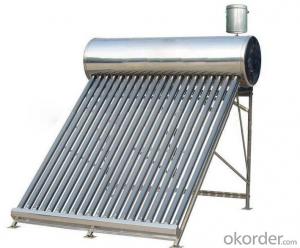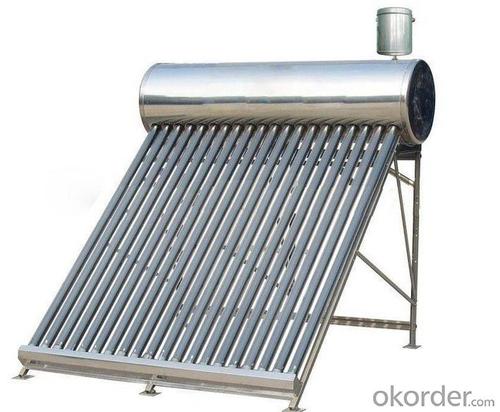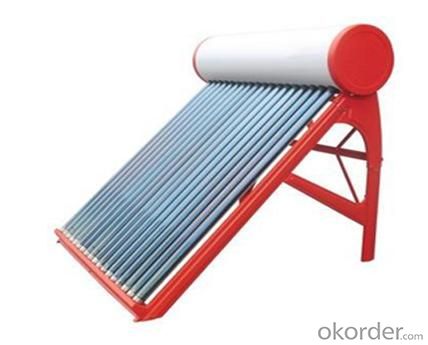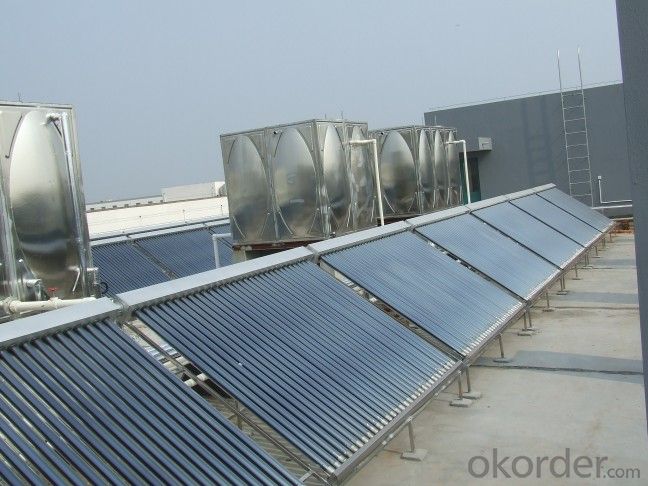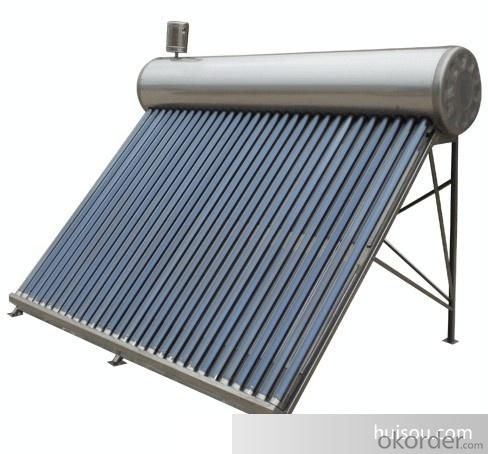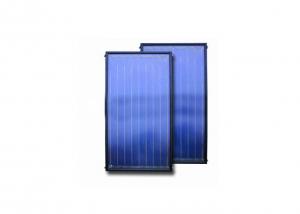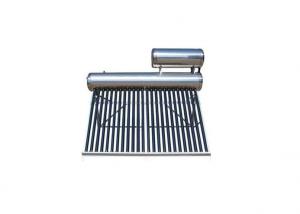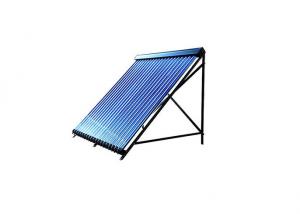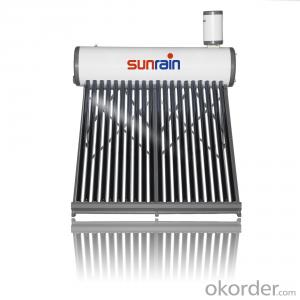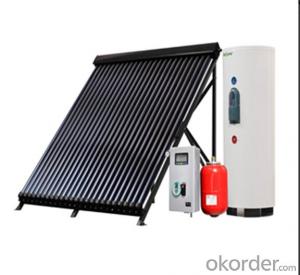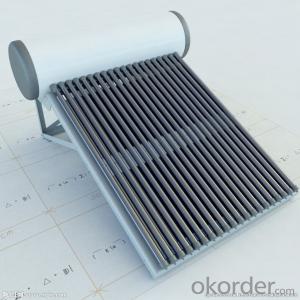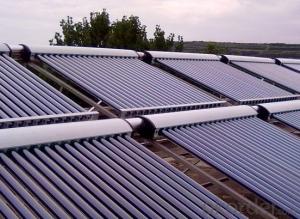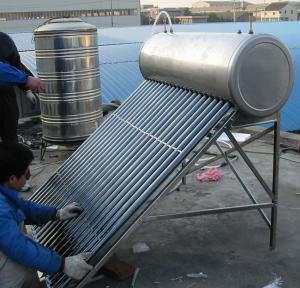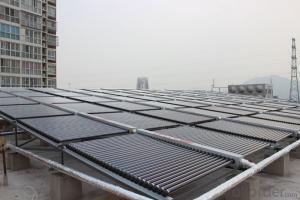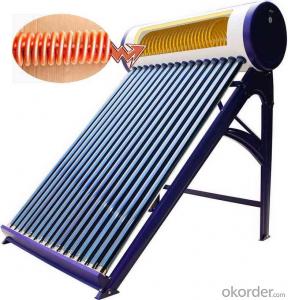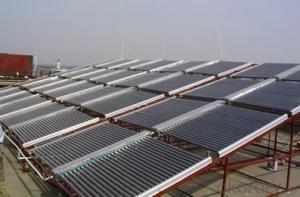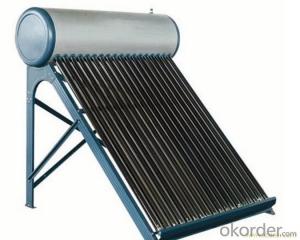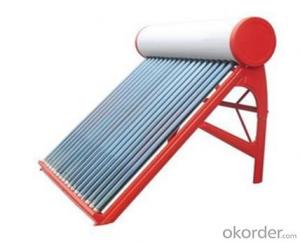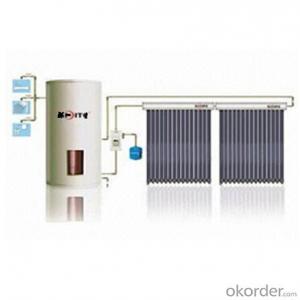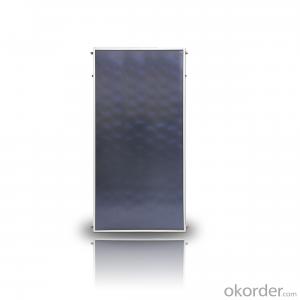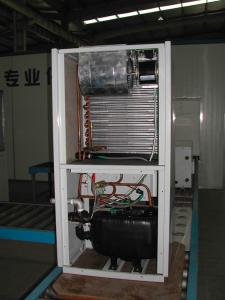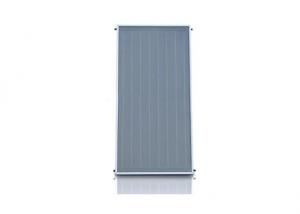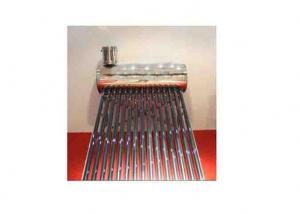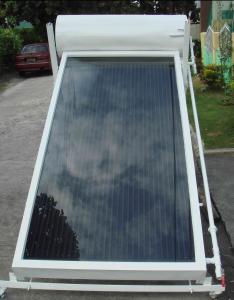Sunearth Solar Water Heater with Copper Coil in Water Tank
- Loading Port:
- China main port
- Payment Terms:
- TT OR LC
- Min Order Qty:
- 1 set
- Supply Capability:
- 6000 set/month
OKorder Service Pledge
OKorder Financial Service
You Might Also Like
Introduction of Non-Pressure Solar Water Heater:
Non-pressure Solar Heater is one of the most economical solar water heating device with pretty high efficiency at the same time. It consists of hot water storage tank, solar vacuum tubes with mouth plug in storage tank, and bracket supporting tank and tubes.When cold water in evacuated tubes is heated with solar irradiation, as the specific gravities of hot water and cold water are different, hotter water goes upward to storage tank and colder water goes downward to glass tubes. through this continuous circulation, the cold water in storage tank will be gradually heated till sunset.
Specialty:
1. High thermal performance and working temperature: the heat exchanging rate even in winter can up above 55%.
2. Heat collecting efficiency is at least 20% above common solar systems.
3. Work in all day and all season: no matter any corner of the world, this system can work well even -40℃ to avoid the tube freezing problem.
4. Reliability: No water following through the tube, so water scale can not generate and tube cracks could be avoided, the system still can keep working even with some damaged tubes.
5. It can connect with water tap and work automatically with pressure0.6Mpa, bring enjoyable washing experience.
6. Safety: P/T valve would release pressure and temperature to protect tank..
Technical Specification:
1. Outer tank material: SUS304 stainless steel or powder coated color steel
2. Inner tank material: 1.2mm thick SUS304 food grade stainless steel ( Optional material SUS316L)
3. Vacuum tube material: borosilicate glass 3.3; AL-SS-CU absorb coating, with copper heat pipe inside
4. Frame material: 1.2mm thickness stainless steel
5. Insulation material: 55mm thickness polyurethane
6. Suitable for mains pressure water(up to 8 bar/116psi)
7. Easy plug-in installation
8. Install the T/P valve on the pressurized tank
9. Seal material: Stabilized High Temperature Silicon
Outer tank material: SUS304 stainless steel or powder coated color steel
Inner tank material: 1.2mm thick SUS304 food grade stainless steel ( Optional material SUS316L)
Vacuum tube material: borosilicate glass 3.3; AL-SS-CU absorb coating, with copper heat pipe inside
Frame material: 1.2mm thickness stainless steel
Insulation material: 55mm thickness polyurethane
Suitable for mains pressure water(up to 8 bar/116psi)
Easy plug-in installation
Install the T/P valve on the pressurized tank
Seal material: Stabilized High Temperature Silicon
19. Vacuum Tube | 20. Size (mm) | 21. Φ47*1500 / Φ58*1800 / Φ70*2100 | |||||
22. Tube (pcs) | 23. 10 / 12 / 15 / 18 / 20 / 22 / 24 / 30 / 36 / 42 | ||||||
24. Material | 25. Borosilicate 3.3 glass, magnetron spluttering selective coating | ||||||
26. Coating | 27. Single-target AL-N/AL or Three-target AL/N-Cu-SS | ||||||
28. Water Tank | 29. Capacity | 30. 80L ~ 500L for hot water storage tank | |||||
31. Inner tank | 32. Food-grade stainless steel SUS304-2B / SUS316 | ||||||
33. Insulation | 34. High-density polyurethane foam with 70~80 hour heat preservation | ||||||
35. Tank shell | 36. Food-grade stainless steel SUS304-2B | ||||||
37. Bracket | 38. Shaped strong aluminum alloy structure adaptable for flat or slope roof | ||||||
39. Accessories | 40. Anti-aging silicon seals, Dustproof seals, Air-vent cap, Stainless screws | ||||||
41. Auxiliary Devices | 42. Assistant tank, Intelligent controller, Electrical heater, Magnesium anodes | ||||||
43. Tilt Angle | 44. 25 ~ 50° | ||||||
45. Water Output | 46. 45 - 95°C | ||||||
47. Hail Resistance | 48. Φ25mm diameter | ||||||
49. Model Number | 50. Solar Vacuum Tube | 51. Tank 52. Liter | 53. System 54. Liter | 55. Container Loading Qty /sets | |||
56. Size /mm | 57. Qty /pcs | 58. 20GP | 59. 40GP | 60. 40HQ | |||
61. VNS-58SA12-100 | 62. Φ58*1800 | 63. 12 | 64. 100 | 65. 132 | 66. 58 | 67. 119 | 68. 140 |
69. VNS-58SA15-130 | 70. 15 | 71. 130 | 72. 170 | 73. 54 | 74. 108 | 75. 131 | |
76. VNS-58SA18-150 | 77. 18 | 78. 150 | 79. 198 | 80. 43 | 81. 86 | 82. 105 | |
83. VNS-58SA20-170 | 84. 20 | 85. 170 | 86. 223 | 87. 40 | 88. 80 | 89. 97 | |
VNS-58SA24-200 | 24 | 200 | 263 | 35 | 70 | 85 | |
VNS-58SA30-250 | 30 | 250 | 329 | 28 | 56 | 68 | |
VNS-58SA36-300 | 36 | 300 | 395 | 23 | 47 | 57 | |
Products Show
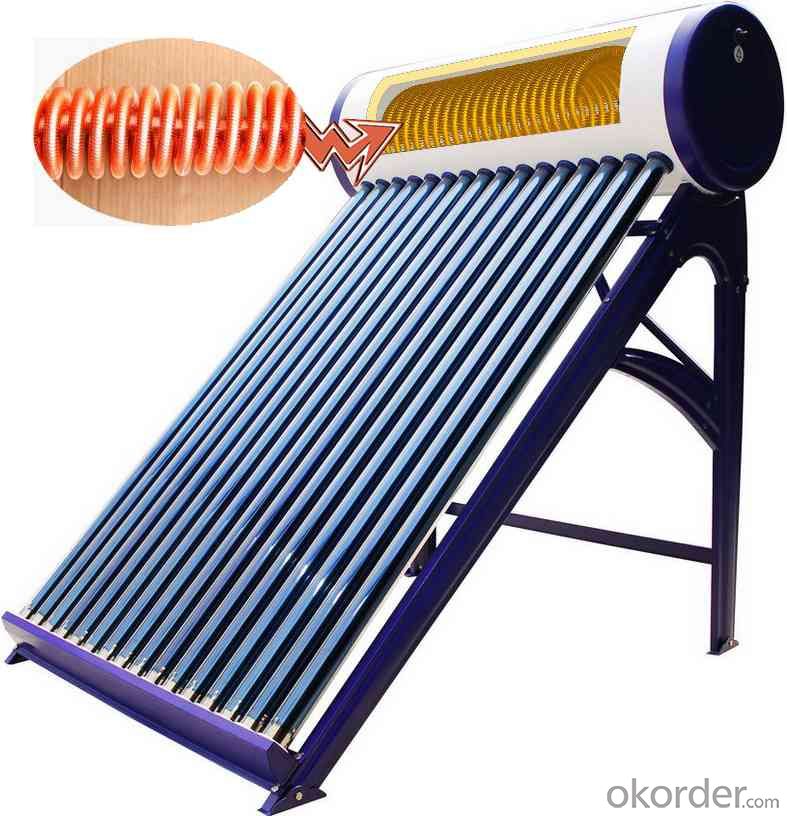
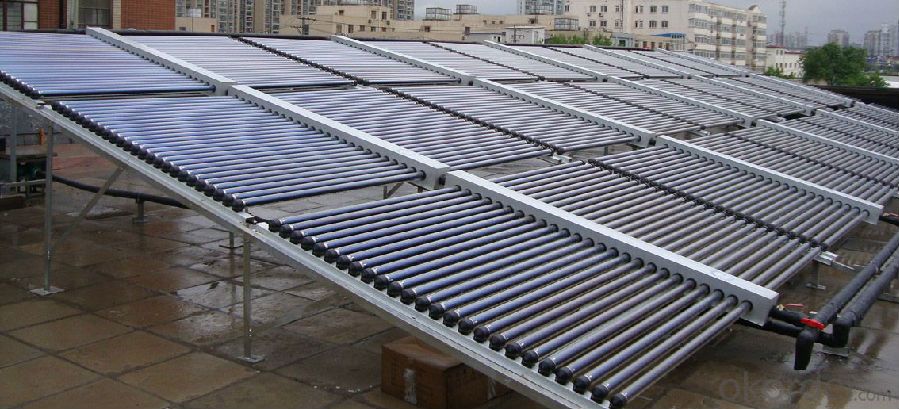
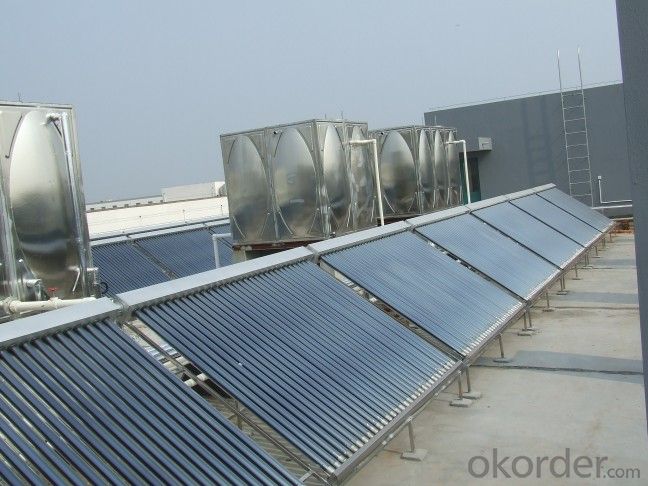
Our Services
1. OEM service
2. Warranty: 5 years
3. Considerable after sale service
Color steel Compact pressure Thermal solar heater
FAQ:
1. What’s the delivery time?
10 days after receiving deposit.
2. How long is the warranty?
5 years for whole system, 1 year for accessory
3. What’s your production capacity?
6000sets/month
4. What’s the MOQ?
1 set.
5. What’s your payment term?
Container: 30% T/T in advance for deposit, 70% T/T before shipment for fist order.
70% T/T after seeing copy of B/L from second order
Sample: 100% T/T in advance
Other choices: L/C at sight.
6. What certifications do you have?
CE, SOLAR KEYMARK, SRCC and etc.
- Q: How does a solar water heater affect carbon footprint?
- Utilizing a solar water heater can make a significant difference in reducing one's carbon footprint. Unlike traditional water heaters that depend on non-renewable sources like gas or electricity generated from fossil fuels, solar water heaters harness the energy from the sun to heat water. This means that they produce absolutely no greenhouse gas emissions while operating, resulting in a substantial decrease in carbon emissions. By harnessing solar energy, a water heater can help alleviate the dependence on fossil fuels for the energy-intensive process of heating water, which accounts for a significant portion of a home's energy consumption (up to 18%, according to the U.S. Department of Energy). This reliance contributes to a substantial carbon footprint. By transitioning to a solar water heater, this energy demand can be met with clean and renewable energy, leading to a noteworthy reduction in carbon emissions. Furthermore, solar water heaters are highly efficient and can provide hot water all year round, even in colder climates. This diminishes the need for backup heating systems, thus further reducing overall energy consumption and carbon emissions associated with water heating. Moreover, the installation of a solar water heater also brings positive effects to local communities and the environment. By encouraging the use of renewable energy, it helps diminish the demand for non-renewable energy sources, consequently reducing the extraction and combustion of fossil fuels. This results in a decline in air and water pollution, as well as the associated adverse health effects. To sum up, a solar water heater effectively reduces one's carbon footprint by utilizing clean and renewable energy for water heating, minimizing reliance on fossil fuels, and decreasing carbon emissions. It presents an efficient and sustainable solution to lessen environmental impact and promote a greener future.
- Q: Can a solar water heater be used in areas with limited access to energy conservation measures?
- Yes, a solar water heater can be used in areas with limited access to energy conservation measures. Solar water heaters rely on the sun's energy to heat water, making them a sustainable and cost-effective option for areas with limited access to traditional energy sources. They can be installed independently of energy conservation measures and provide a reliable and efficient way to heat water.
- Q: How does a solar water heater perform in cloudy or rainy weather?
- A solar water heater's performance is affected in cloudy or rainy weather as it relies on sunlight to heat the water. During such conditions, the heater's efficiency may decrease, resulting in a slower or less effective heating process. However, some solar water heaters are equipped with backup systems or can store excess heat, allowing them to continue functioning to some extent even in unfavorable weather conditions.
- Q: How does the orientation of a solar water heater affect its performance?
- The orientation of a solar water heater greatly affects its performance. Ideally, the heater should be facing south or within 30 degrees of due south to receive the maximum amount of sunlight throughout the day. This ensures that the solar panels capture the most sunlight and convert it into usable energy to heat the water. If the heater is not properly oriented, it may receive less sunlight, resulting in reduced efficiency and lower water heating capabilities.
- Q: How much space is required for installing a solar water heater?
- The space required for installing a solar water heater depends on various factors like the size and type of the system, the number of solar panels, and the available roof or ground space. Generally, a typical residential solar water heater requires around 20 to 40 square feet of roof space for installation. However, it is recommended to consult with a professional installer to assess your specific requirements and available space for an accurate estimation.
- Q: I live on the 3 floor, solar energy and water tower on my upstairs is on the 4 floor, 2 floor 1 floor downstairs but people when they can mix the warm water bath, why my warm water will not come out, only hot water (very hot, there are an estimated 70 degrees) or only cold water. I feel hot and cold water mixed can not afford it, but my father is also installed in the solar energy where a small pump,
- This is a hot and cold water pressure difference, the solar water heater usually we buy most of the drop type solar water heater, the water heater for hot water down the gap (the gap is larger water pressure, water pressure drop is small, so the smaller) hot water pressure is very small. Water temperature is not high, it is relatively easy to adjust, when the water temperature is not good adjustment. This is because the general situation of cold water pressure in two to three pressure, while the drop type solar water heater is generally the top layer of pressure in the pressure of about zero point three, the pressure difference between cold and hot water is very large. The water temperature is not high, because the small cold, so cold water pressure will be reduced, this time it is easier to adjust; the water temperature is high, because a little hot water will be a lot of cold water to reconcile the suitable water temperature, then hot water is very small, less pressure, cold water to open a large, between them the pressure difference is greater
- Q: Decoration is a hotel, 3 floors, each floor of 295 square meters, a total of 22 rooms, and now want to install solar water heaters in the roof to provide hot water to the hotel, I do not know what brand installed, how to install? If there is a better local solar provider in Urumqi
- The utility model has the advantages of stable hot water, convenient use, no need to be used for it, no need to be bothered, and the traditional positive displacement electric water heater is the best choice. Has been quite mature, can not leak for decades, like high-grade real estate almost all supporting the volume of water heaters. Nothing more than stability, do not want to bother, do not want someone to repair the door.
- Q: How to buy solar water heater to check its quality?
- Usually through the instrument testing, to see if it is in line with national standards. If only by experience to identify, you should pay attention to these aspects. 1: consumers in the purchase of the product must be on the water heater, heat exchanger, pipeline interface and core board factory conducted pressure test and leak check, at the same time on their types and materials and consumer requirements are considered. If you can choose according to their own economic conditions of different prices of products
- Q: The controller of the solar water heater does not show the power on screen
- Solar water heater controller power screen does not show the reasons for:1, the transformer is broken;2, the control board is no electricity;3, the chip is broken;4, the display is broken.
- Q: Can a solar water heater be used in areas with limited access to solar financing options?
- Yes, a solar water heater can still be used in areas with limited access to solar financing options. While solar financing options may help make the initial investment more affordable, it is not a prerequisite for using a solar water heater. Individuals in these areas can explore alternative ways to finance the system, such as local grants, government subsidies, community-based funding, or even self-financing. Additionally, the long-term cost savings and environmental benefits of a solar water heater may outweigh the initial investment, making it a viable option for areas with limited solar financing options.
Send your message to us
Sunearth Solar Water Heater with Copper Coil in Water Tank
- Loading Port:
- China main port
- Payment Terms:
- TT OR LC
- Min Order Qty:
- 1 set
- Supply Capability:
- 6000 set/month
OKorder Service Pledge
OKorder Financial Service
Similar products
Hot products
Hot Searches
Related keywords
